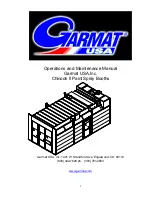
4-46
4.2 Operation and features
SPM-32A ... SPM-36A
Example: Setting the 25 Hz filter bandwidth
4.2.5
Level mode
The results are displayed in terms of an absolute level or a
level difference.
Levels express the ratio of two quantities. One quantity may
be a reference, i.e. a certain power or a certain voltage
(dBm, dB) and these are referred to as absolute levels.
Relative levels are the difference between two levels.
The instrument can measure the following:
– absolute voltage and power levels (ABS)
– level differences (ABS-REF)
– level in dBm0
*
4
25
ABS
dBm0
ABS
→
REF
ABS-
REL(dBr)
REF
REF
Summary of Contents for SPM-32A
Page 1: ...SPM 32A SPM 36A Selective Level Meters Operating Manual BN 4033 00 82 ...
Page 2: ......
Page 16: ...2 Safety information SPM 32A SPM 36A 2 4 Notes ...
Page 118: ...5 10 Ordering information SPM 32A SPM 36A 5 20 ...
Page 122: ......
















































